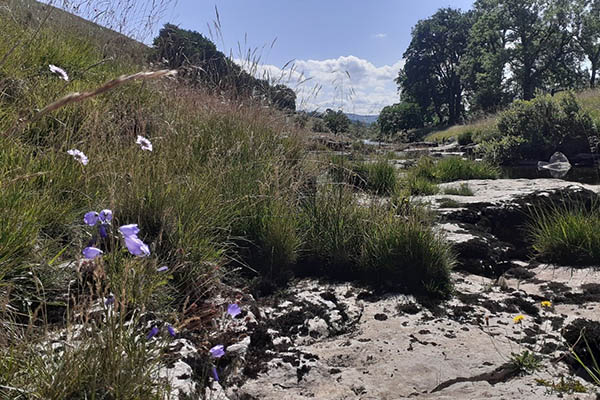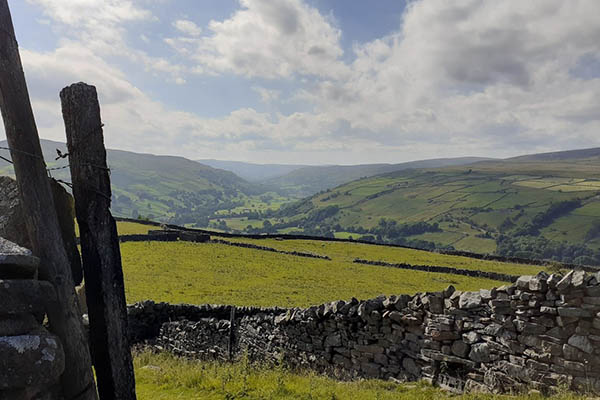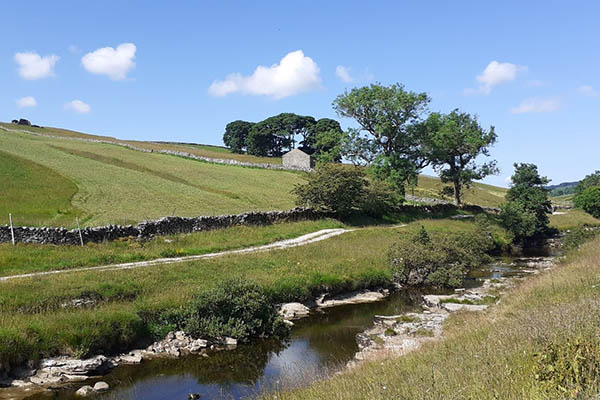Well, to its farmers, actually. Most years, we head to Italy or France for our summer holiday. Our treasured Landmark short stays tend to happen at other times of the year. This year, no doubt like many others, we found Landmark occupancy so high due to deferrals and other staycationers that we had to turn elsewhere. And so in early July we found ourselves taking a week in Swaledale.
The beauty of this part of England never fails to make you catch your breath. It’s partly the contrast of the wide and lonely high fells with the gentler intimacy of habitation nestled along the Dales, but it’s equally the signs of the dogged human endeavour written across the landscape in only the resources that came to hand: the scattered field barns, the foursquare farmhouses, the marching gridlines of the drystone walls dividing the slopes and leas into divisions ascribed long ago.
We arrived at our 300 year-old lead miner’s cottage full all of the usual superficial questions: where does the stone come from for all those walls (from clearing the ground as much as quarrying), how old are they (as old as humans have herded; some in the Dales were built by Vikings), how long do they take to build (how long is a piece of string).
 Wildflowers along the River Wharfe in Langstrothdale
Wildflowers along the River Wharfe in Langstrothdale
And what walking there is. The ruined relics of long-closed lead mines prompted more questions, as we realised that industry too had once been part of today’s pastoral scene. The joyful profusion wild flowers along the verges and river banks made me brush up on my childhood wild flower lore (thanks, Willersey 1st Brownie pack), and we lost ourselves in the antics of the house martins, swifts and swallows, and the buzzards and kestrels wheeling in the sky and the oystercatchers paddling in the river.
Son and partner joined us for a few days, Dom by chance just finishing Cumbrian sheep farmer James Rebanks’ book, English Pastoral (2020). The worthy historical reading I’d brought suddenly seemed less appealing in such a setting and I pounced on this, read it in almost a sitting. Rebanks farms his Herdwick sheep some 60 miles NW or so from Swaledale and the farming traditions of the two areas merge and overlap.
He’s a compelling advocate of the need for ancient traditions of active intervention in wild landscape to continue, in contrast to the vast fields of intensive agriculture. Rebanks makes the case for working with nature to ensure the continuing richness of biodiversity and habitats themselves enriched by millennia of human interaction. This is especially true for adapting wilder, marginal areas to productivity, achievable only by acting on the advice of ecologists and environmentalists – which often simply means a return to traditional farming ways. He delights in the biodiversity that returns when such farming practice reverts closer to the pre-agrochemical days of our grandfathers, unlocking the natural symbiotic productivity of the land.
Humankind has worked these fells for millennia, since we first turned from nomadic herding to settled farmsteads. The new-found fashion for rewilding must be balanced with productivity and livelihoods in wild areas, the quest for biodiversity be acknowledged to rest on the age-old grazing habits of sheep and cattle hefted to our fells and moors. There is a role for humans to play in the ordering of Nature (and we do respond to the pleasing order of those dry stone walls marching across the lonely fells), but it is as guardians and stewards, not as pillagers. We must tread lightly, work with the grain of Nature, not against it.
 The drystone walls of Swaledale
The drystone walls of Swaledale
I had English Pastoral about my mind the day we drove over Beggarmans Pass and into Langstrothdale, to drive along the Wharfe as it chuckles over the stones below Cowside, hiding on the slope above behind its stand of sycamore trees. It’s 10 years since Landmark rescued this typical example of a Dales farmstead, left stranded when the way of life became too marginal for its last farmer, left off-mains and off-grid. Our instinct that it deserved to be rescued was vindicated as Cowside’s history was teased back to the 1680s, and still more when we discovered rare 17th-century wall paintings beneath flaking limewash in the ancient parlour.
Yet at the time this too was another conservation conundrum. The creeping tide of conversion of old buildings to holiday homes in the Dales is also controversial: could Cowside have housed another generation of another farming family instead?
The answer in this case was no, as indeed for all Landmark’s restorations. After standing empty more than 50 years, the cost at Cowside of bringing in running water and electricity to the fellside, for the specialist timber repairs, the re-roofing in huge stone roof tiles would have been beyond any private owner. Had Landmark not stepped in and succeeded in raising the funds for the restoration, Cowside’s walls would soon have crumbled to rubble. It had gone far beyond rescue as a working farmstead.
 Cowside lies hidden in the clump of trees behind the field barn above the Wharfe.
Cowside lies hidden in the clump of trees behind the field barn above the Wharfe.
It was a glorious sunny day as we followed the road along the Wharfe below, and a red tractor was cutting hay on the fields around Cowside – as it seems every farmer in the Dales was doing that sunny week. The air was full of the scent of new-mown hay. I hadn’t realised how far each of the Dales has its own character: Langstrothdale feels secret and ancient, no traces of vanished lead mining here, just lush riverside meadows full of meadowsweet, scabious and red campion as the sunlight sparkled on water chattering shallowly across the distinctive black and beige boulders of the Wharfe.
And yes, how right to intervene to rescue Cowside, and to give it a new use that ensures it can be maintained in the landscape, a reminder in itself of the long generations of hard-grafting farmers who keep the landscape we so love in good heart and productivity.
Many hundreds have stayed at Cowside since it opened in 2011, on their own trail of discovery and enjoyment of these wild yet gently managed parts. If they don’t already bring a deeper understanding of what makes the Dales so special, perhaps like me their stay opens their eyes to the importance of cherishing and supporting the ways of farming life that made the Dales what they are and keep them what they are. As far as we are each able, we owe it to such food producers and farmers to support their stewardship of these wider landscapes, ecosystems and local economies as we make our own food and holiday choices – and, when we are lucky enough to share even briefly in the landscape they continue to shape, to tread lightly ourselves. I can’t wait to go back.
Discover Cowside